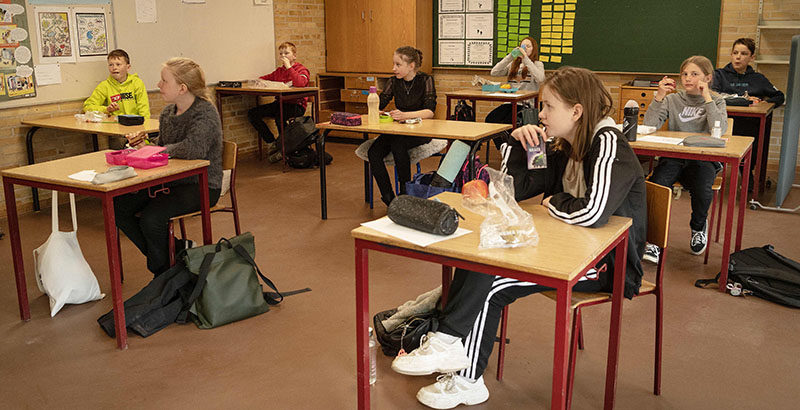Coronavirus Must-Reads for Schools: Educators Eye ‘Great Reopening’ During Time of Distancing, Remotely Reaching Troubled Students, More Equitable Distance Learning & More

This is a special edition of EduClips, our recurring roundup of top education headlines from America’s 15 largest school districts, where more than 4 million students across 10 states typically attend class every day. See our full EduClips archive right here.
Last week, Denmark became the first major industrialized nation to reopen schools during the pandemic. There were some clear rules: Desks, for instance, had to be two meters (about 6.5 feet) apart, leading to once-luxurious teacher-student ratios of 10 to 1 in many classrooms. Students had to wash their hands once an hour. And parents weren’t allowed inside. “It is a new world,” said Tanja Linnet, the head teacher at Copenhagen’s Logumkloster District School. “We used to make plans for if there was a terrorist attack here — but never this kind of attack.”
Is Denmark a harbinger of things to come? It will take a while to find out. Most European countries aren’t ready for such a bold move. In Spain, for instance, most children haven’t been outside in five weeks. Schools throughout Asia remain closed. In China, where the pandemic originated, schools have yet to reopen in most parts of the country; the capital, Beijing, will see high school seniors return to class next week.
For most of the U.S., that reality is likely months away, and in one of the world’s more famously decentralized education systems, it will entail adjustments that were once unthinkable. “If you think you’re going to keep kids six feet apart during the course of a school day, you’re dreaming,” Dan Domenech, executive director for the American Association of School Administrators, told USA Today. In Denmark, the increase in classrooms necessary to facilitate social distancing has translated into teachers doing more. What will this mean in the United States, which was facing a dramatic teacher shortage before the pandemic? Will states ease restrictions to licensure, for example, perhaps setting up confrontations with teachers unions?
If schools require students to wear masks and gloves, there are national shortages to contend with, and many states cut back on school nurses in response to previous budget cuts. Finally, many school buildings were simply not built for the rigors of social distancing. The West Contra Costa Unified School District, near San Francisco, has no unused classrooms; gym classes often have more than 50 students, and schools stagger lunchtimes so students can sit eight to 10 kids to a table. “We can’t just build new schools overnight,” Tony Wold, the associate superintendent, told the Associated Press. “Even if the state gives us more money, where will the teachers come from?”
In keeping with America’s decentralized ethos, the Great Reopening will likely be highly regionalized. President Trump, in his three-phase plan to jump-start the economy, said that sending children back to school is a decision that will be largely left to governors. Already, that plan has sparked confusion: It calls for reopening schools but also maintaining physical distancing and banning groups of 50 or more. California Gov. Gavin Newsom stepped into the breach early, offering up ideas such as staggering school schedules, with some students arriving in the morning and the rest in the afternoon, while rethinking how to handle school mainstays like assemblies and gym. Most state leaders predict that they won’t be ready to move until at least the fall. But officials in two largely rural states — Idaho and Wyoming — have not ruled out opening classrooms this summer.
Top stories
Equity — Philly Students Without Internet Can Do Remote Learning in Parking Lots, District Says (Read at Billy Penn)
Teen Jobs — Children Take to the Fields Following School Closures (Read at Idaho News)
Unions — Online School Demands More of Teachers. Unions Are Pushing Back (Read at The New York Times)
Pensions — Report: Teacher Pension Debt Is ‘Crowding Out’ Funding for Education (Read at Education Dive)
Mental Health — Distanced by Pandemic, School Psychologists Improvise Ways to Connect With Struggling Students (Read at The74Million.org)
‘Social distance’ learning
Technology Shortage Hits Schools: As Remote Learning Jolts Demand for Chromebooks and iPads, Districts Warn Communities’ Needed Supplies Could Take Months (Read at The74Million.org)
Most Illinois School Districts Did Not Have Approved E-learning Plans Before the Pandemic (Read at ProPublica)
Over a Million California Students Still Lack Access to Remote Learning (Read at Calmatters)
Analysis: A Month In, Districts and Charters Make Progress on Online Instruction and Monitoring Student Progress, Lag in Grading and Attendance (Read at The74Million.org)
Teachers Need Lots of Training to Do Online Learning Well. Coronavirus Closures Gave Many Just Days (Read at The Hechinger Report)
Parents and families
What Will Summer in NYC Look Like for Kids? Camps, Pools, and other Programs Face Cuts (Read at Chalkbeat)
School Counselors Have a Message for Kids: ‘It’s OK to Not Be OK’ (Read at NPR Illinois)
New York Parents Are Stressed Out About Their Children Falling Behind, Survey Finds (Read at Lohud)
Educators
Denied a Diploma, April Dunn Made Sure Other Students With Disabilities Had Options. She Died of COVID-19. (Read at The Washington Post)
‘An Unknown They’ve Never Experienced Before’: As Coronavirus Death Toll Grows Among NYC Teachers and Staff, Union Support Team Ramps Up Its Efforts (Read at The74Million.org)
See How Videos Are Bridging the Divide Between Students and Teachers (Read at Connecticut Insider)
Teach New Content or Review Familiar Material? A Tough Call During Coronavirus Closures (Read at Ed Week)
Unable to Complete Student Teaching Requirements, Prospective Teachers May Soon Get Reprieve (Read at Ed Source)
Special education
Some Kids With Disabilities Can’t Learn at Home. Parents and Advocates Want to Know: What’s the Plan? (Read at The Connecticut Mirror)
California Should Push Harder for Special Education During School Closures, Disability Rights Groups Say (Read at EdSource)
Equity and activism
Many Trans Students Have Been Forced to Hide Their True Selves Because of College Closures (Read at Buzzfeed)
For Homeless Students, School Provided More Than an Education. Here’s How They Are Coping Now (Read at Chalkbeat)
Schools Transform Into ‘Relief’ Kitchens, but Federal Aid Fails to Keep Up (Read at The New York Times)
For NYC Students Learning English, Remote Learning Can Come With Steep Barriers (Read at Chalkbeat)
Homeless Families Face High Hurdles Homeschooling Their Kids (Read at NPR Illinois)
Essays and reflections
The Risks of Homeschooling (Read at Harvard Magazine)
Forced to Throw Out Their Old College Admissions Standards, Higher Ed Institutions Should Seize on the Crisis to Create Better Ones for the Future (Read at The74Million.org)
Taking Attendance During Coronavirus Closures: Is It Even Worth It? (Read at EdWeek)
Student Voice: Two Weeks, Five Siblings and One Working Laptop. How I Navigated the Nation’s Largest School System in Search of an iPad and What It Taught Me About America’s Digital Divide (Read at The74Million.org)
Hey FCC, Step Up and Make Sure Internet Reaches the Families Who Need It Most (Read at Education Post)
QuotED
“It is so nice to see my best friend again!” —Maja Petersen, a 7-year-old first-grader, on schools opening in Denmark. (Read at The New York Times)
“There’s a lot of fear now of a different type of unknown, an unknown that they’ve never experienced before.” —Tina Puccio, director of the United Federation of Teachers’ Member Assistance Program in New York City, where more than 60 school teachers and staff have died from the coronavirus. (Read at The74Million.org)
“It almost shows a disregard for the safety of kids, because what seems to be the most important element here is that schools be open to serve their child care function, so that parents can get back to work.” —Dan Domenech, executive director for the American Association of School Administrators, on President Trump’s plan to restart the economy. (Read at USA Today)
“Everybody says we hope we return to normal. It’s not going to return to normal anytime soon because the new normal is going to be different.” —Robert Hull, president and chief executive of the National Association of State Boards of Education. (Read at The Associated Press)
“Isolation has been really hard for me. It feels like many things that gave me joy are now gone.” —Jada Bromberg, 16 and a sophomore at W.T. Woodson High School in Fairfax, Virginia. (Read at The74Million.org)
Get stories like these delivered straight to your inbox. Sign up for The 74 Newsletter

;)
